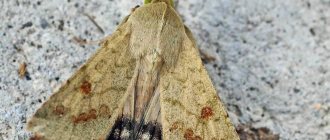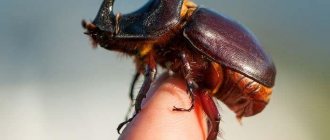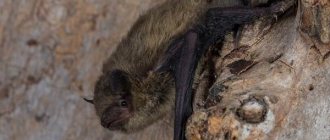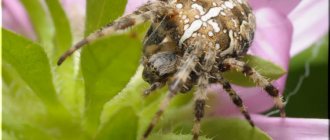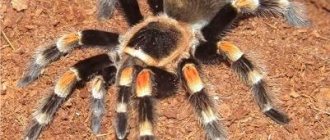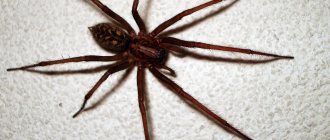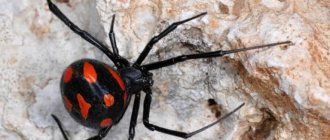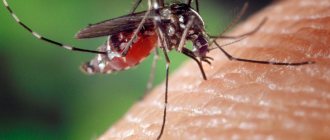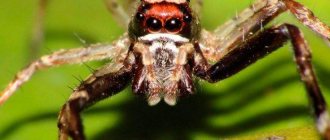Yellow sac spider
It is found in the Rostov and Volgograd regions, and was recently discovered in Bashkortostan. The spider, no more than 1.5 cm in length, has an aggressive disposition and can easily bite. A person who is unlucky enough to meet him will feel a sharp, stabbing pain at the site of the bite. The venom of the yellow sac spider is not so toxic as to cause serious harm to health, but unpleasant sensations are guaranteed to the bitten person.
Dangerous and harmless species of large spiders in Russia
Each type has distinctive characteristics, appearance, and lifestyle in accordance with its habitat. The range of arthropods may change due to climate change. Species that occupied certain regions migrate and colonize new territories.
Features
These arthropods have 4 pairs of legs. On the front there are poisonous claws - chelicerae. There are 6 spider warts at the bottom of the body, paired eyes on the head. Their number depends on the species (8 or 6, sometimes 2 eyes).
Food is digested outside the intestines. The spider injects liquefying enzymes into the victim, and then sucks out its insides.
Note! Spiders do not attack animals or people first, but bite only in case of danger. This is their defensive reaction.
On the forelimbs there are bulbs containing sperm for fertilizing the female. After mating, the spider kills the male, and therefore the life expectancy of the latter is much shorter than the female. Sometimes the spider manages to escape. For the safe growth and development of newborns, the mother places them in a cocoon she has woven.
Cross
About 30 species of cross spiders have taken root in Russia. They climbed into forests, gardens and parks, some of them found refuge in abandoned buildings. These 4cm long spiders have a hard-working nature, as every couple of days they dismantle their old web and create a new one in its place. They are not dangerous to humans, but in rare cases their bite can cause a burning sensation in the wound area and short-term discomfort.
In the central part of the Russian Federation
The central part of Russia is characterized by pronounced seasonality. The climate is mostly humid and is not suitable for all arthropods. The following spiders are found here:
Silver spider
The only underwater representative of the world of spiders, the popular name is dropsy. Lives in bodies of water with standing water. The silverfish species are small spiders up to 15 mm in length, brown in color. Since dropsy is the only spider that is found on the surface of lakes and ponds, it cannot be confused with anyone else. If you disturb such a resident of a body of water, you may get a bite. Its venom is not dangerous to humans; the result of a bite is pain near the bitten area, which disappears in a few days.
Heiracanthium
Heiracanthium is the Latin name for the green spider in Russia. Popularly called sak or yellow-bag. The places where saka is distributed are Crimea, Krasnodar Territory, Rostov Region - it loves warm regions. Climate change is contributing to its emergence throughout the central part of the country.
The abdomen is yellow or beige, the cephalothorax is often orange, the green spider grows up to 15 mm. Its color appears green against the background of the leaves, hence the name. Sak builds web sacs and has the ability to jump. It has large chelicerae and poisonous claws; the yellowjacket bites painfully. The first sensations from a Heiracanthium sting are similar to those of a bee - a sharp, severe pain. The consequences can be different - from a long-healing wound to nausea and an allergic reaction. Depends on the age and health of the person.
Knitting spider
Popularly called the grandmother's spider. It often settles with a person, occupying corners of the apartment, cracks behind furniture, and weaves its “classic” web. It grows up to 1 cm, has a light brown color and an elongated abdomen on long legs. The knitter is absolutely harmless; when meeting a person, he prefers to pretend to be dead: fold his paws and sit motionless until the threat disappears.
Silver spider
The only underwater arachnid inhabitant of Russia is widely distributed in the Caucasus, Siberia and the Far East. He almost never goes on land, and only emerges to take in another portion of air and take it to his cocoon home. This small spider, only 1.5 cm long, can bite, but only if provoked. At the same time, it will release a little poison, and in this case nothing threatens a person. At most, the wound from the bite will hurt for several days.
Dangerous classes
There are varieties of spiders that secrete a toxic substance. Medical intervention after a bite is required to neutralize the consequences. You need to know the names of the most dangerous spiders in Russia, which live in different regions, in order to protect yourself from bites.
Common crosses
The diet of this arthropod species consists of insects. The cross eats flies, bees, hornets, mosquitoes, butterflies and other flying insects, which it catches with the help of a web. The cross immobilizes prey with poison, then entangles it with threads. He injects liquid digestive enzymes into the victim's body, from which the body softens and turns into a semi-liquid state. After a while, the executioner eats the half-digested contents. The crossfish makes provisions for the future; if it is full, it hangs the prey from the edge of the fishing net.
This species is not one of the largest spiders in Russia; females grow up to 20−25 mm, but males are smaller in size (10−11 mm), as with all arachnids. The white cross lives in all regions of the country and prefers the atmosphere of beech, spruce or pine forests. Individual representatives are found in arable lands, swamps, meadows and orchards with fruit trees.
Characteristic features of the appearance of the cross:
- Body color depends on external lighting. On the back there is a pattern in the shape of a cross, for which the spider got its name.
- The representative's carcass is covered with a waxy layer. This substance protects the body from excessive evaporation of moisture on hot days.
- In front of the head there are 4 paired eyes, and the cephalothorax is covered with a dense and dense shield.
- At the back of the abdomen there are 3 pairs of arachnoid warts. On the surface of each formation there are hundreds of tiny holes.
Representatives breed in August; for males, mating games often end with eating. The male attracts the female by twitching the signal thread on the web. To lay eggs in the fall, the female makes cocoons from specially spun webs and dies after laying. The eggs overwinter in this cocoon, and the spiders are born in mid-spring. Sexual maturity occurs only after the next wintering.
Harmful chiracantids
Dangerous arthropods are found in grass and shrub thickets. This species belongs to the poisonous spiders of the middle zone. Chiracantids are vagrant individuals and do not weave any web traps. The highest activity occurs at night, hunting from tactile contact with the spider. Usually the victim touches the legs of a hidden hunter, who attacks her in a jump. The diet consists of caterpillars, grasshoppers, moths, aphids, and mites. Spiders of this species avoid contact with wasps and ants.
Characteristic appearance features:
- the body is painted in a light brown, yellowish or greenish color;
- the size of the female ranges from 0.5−1.5 cm;
- the carcass is oval-shaped, the back part is somewhat pointed;
- the front legs are longer than the others and larger than the body.
After a bite, severe pain appears at the site of the lesion, a burning sensation is felt, and the symptoms gradually spread to nearby areas. There is no itching or numbness in the muscles, but the lymph nodes located in the path of the poison begin to swell and ache. Stiffness and swelling develop a little later, sometimes the person cannot breathe freely.
If help arrives in time, the pain subsides within a day, and other symptoms disappear within 2 days.
Poisonous karakurt
This species is recognized as the most poisonous and belongs to the so-called black widows. Representatives live in the southern regions of the Urals, in the Caucasus, in the Astrakhan and Volgograd regions. In recent years, the range has shifted to the northern regions, reaching the Moscow region, which scientists explain by climate warming.
The species does not settle in residential buildings and will never live in a multi-story building. Prefers a hot climate and lives in steppe regions. The spider's enemies are hedgehogs and wasps. Near housing, the spider builds burrows in landfills, in piles of firewood, and in cluttered areas of dachas.
Appearance of karakurt:
- the body is black or gray-black, with red spots with white edging;
- The size of the female reaches 1.5−2.0 cm, and the males grow up to 0.7 cm.
The older the spider, the darker its body, and the bright spots become less noticeable over the years. The female's venom is dangerous to humans only after 5-6 molts; before that, the venom is not so poisonous.
The female builds a den in soil depressions, often uses ready-made rodent burrows, drainage pipes, and places nets at the entrance for protection. The eggs spend the winter in a cocoon, and in the spring the young spiders scatter in the wind with their webs.
The karakurt attacks animals and humans if it is disturbed. After a bite, a burning pain quickly spreads throughout the body. Severe pain occurs in the abdomen, chest, lower back, shortness of breath appears, the pulse and heartbeat increase. In later periods, excitement gives way to depression, delirium appears, and consciousness becomes confused. For relief, anti-karakurt serum, novocaine, sodium hydrogen sulfate, and calcium chloride are used. The patient needs urgent medical attention.
South Russian tarantula
A light gray spider with a body length of up to 3 cm lives mainly in dry climates, settling in forest-steppe, semi-desert, steppe. To live, it digs a hole up to 40 cm deep and covers the walls with cobwebs. Looks out for the victim in the shadows as it passes by the entrance. After this, it instantly bites the prey, immobilizing it.
The tarantula attacks only when there is danger; it can jump up to 15 cm in height to attack. Its bite is not too painful, but without medical help it causes nausea, fever, and swelling of the lymph nodes. Deaths are rare, but health problems are common.
Tarantulas mate closer to autumn. To attract a female, the male makes a vibrating sound in the abdomen and actively moves his legs. Males have an ingrained habit of running away after mating to avoid being eaten. The spider bears offspring on herself, for this she weaves a cocoon and attaches it to her body. When the babies hatch and begin to move, she gnaws through the cocoon and helps them leave the shelter. But then the spiders climb onto the mother’s body and remain there for some time.
Tarantulas overwinter in the ground, filling the entrance hole with soil. If representatives remain in a warm place, for example, close to human habitation, then they do not hibernate. But the absence of winter suspended animation shortens the spider’s lifespan, which in nature is about 2 years.
Argiope Brünnich
The striped color of these spiders resembles that of a wasp, but only females have this appearance. The spider wasp lives in many southern regions of Russia, gradually expanding into more northern latitudes. The female's body length is about 1.5 cm, but this is enough for her to inflict rather painful bites. The venom of Agryope Brünnich is not dangerous to humans; swelling and itching at the site of the bite go away very quickly.
Hunter striped
In the Saratov region, 4 species of the family Pisauridae were discovered - hunting spiders belonging to 2 genera: Dolomedes and Pisaura. But only one of them is listed in the Red Book of the Saratov Region. This is a striped hunter.
Hunter striped
The name “plant” in this case is incorrect and is a copy of the Latin name of the species Dolomedes plantarius. Plantae is Latin for "plant".
Female striped hunters grow up to 2 cm. Males average 11 mm. In terms of description and appearance, the striped hunter is very similar to its “relative” – Dolomedes fimbriatus, whose name in Russian taxonomy is bordered. Both species live in the same area and are easily confused.
Striped and edged hunters differ in the width of the light stripe running along the entire body. The stripes begin from the cephalothorax and close at the end of the abdomen. The striped border on the cephalothorax is wider than on the abdomen.
Color brown. The abdomen is oval. The legs are thick, long, equipped with large spines.
Interesting!
These spiders can run on the surface of the water for some time.
Striped hunters live near water bodies. They also catch prey there, lying in wait for it at the water's edge. Females become sexually mature at 2 years. They breed twice a year. At one time, the female lays 500-600 eggs.
South Russian tarantula
Mizgir, as this spider is called differently, lives in Siberia and southern Russia. This is a small spider, its body length does not exceed 3 cm. For hunting and a comfortable life, it settles in a hole at a depth of 40 cm and lines the entrance to it with cobwebs. He is not hostile to people and rarely bites. But if he does this, he will definitely inject poison. The bite of the South Russian tarantula is very painful, often there is extensive swelling in the affected area, and the skin may turn yellow. But it does not lead to death.
Karakurt
In total, 10 spiders are classified as conditionally poisonous in Russia. They make up the poisonous top 10. The most memorable of the top spiders and also the most poisonous spider in Russia is the karakurt. Characteristic black color. There are 13 red spots on the dorsal part of the abdomen.
Karakurt translated from Turkic means “black insect” (kara “black” + kurt “insect”). Kazakh legends say that the bite of this arthropod kills a camel. The spider lives in the steppes and desert regions of Central Asia, Ukraine, Russia, and the Mediterranean region. In Europe it is known as the “European black widow”.
View this post on Instagram
A post shared by Victor Ray (@v1cr4v)
The species Latrodectus tredecimguttatus belongs to the genus of black widows. It is considered aggressive, but only bites a person when it believes that the person is dangerous to the nest in which the egg sacs are located. It settles in places where garbage accumulates, including in street toilets. It is attracted by clusters of flies - the favorite prey of the black hunter. Therefore, people should avoid collecting cobwebs in sheds, basements and garages near openings. Karakurt settles in holes in the ground left by rodents, or in crevices.
Not lethal to humans. When bitten, a small amount of venom is injected, which feels like a pin prick. The person experiences muscle pain, chills, and nausea. A karakurt bite will be fatal only for those who are allergic to spider venom, i.e. for 5% of people.
Steatoda
Several species of these spiders have settled in the south of Russia, in the Caucasus and the Black Sea region. They often live in close proximity to humans, setting their traps in gardens, vegetable gardens, garages and other human buildings. They are similar in size, color and shape to the famous black widows, for which they are also called false widows. However, they are much inferior to them in toxicity. A steatoda bite, as a rule, does not lead to death, with the exception of people who are allergic to certain components of the poison. In most cases, people experience burning pain, increased body temperature, and blisters and redness at the site of the bite. Feeling unwell may last for several days.
What to do if you are bitten
Often, at the sight of a large spider, people simply panic, causing an aggressive response in their address, which leads to a bite. First aid in this case is as follows:
- If possible, take a photo of the “offender” so that you can identify him later.
- Wash the bite area with warm water and soap for 3-5 minutes.
- Apply a tight bandage above the bite site and apply a cold compress directly to it (this will slow down blood circulation, preventing it from spreading poison throughout the body). For the same purpose, it is necessary to minimize physical activity, normalize breathing, and calm down. Drink as much fluid as possible (including on the way to the hospital to reduce the concentration of toxin in the body).
- To relieve the primary symptoms, take any analgesic; if you don’t have anything at hand, take regular aspirin. If you are prone to allergies, also take a tablet of a suitable antihistamine.
- Go to the hospital as soon as possible for more qualified medical care.
The symptoms characteristic of a karakurt bite, even after the administration of a special serum, weaken, but do not disappear completely
Video: first aid for a spider bite
For a Russian gardener, an encounter with a poisonous spider is a rare, but not impossible, occurrence. Most of them are not aggressive by nature, so it is better to simply avoid a suspicious individual. In the event of a bite, it is necessary to go to the hospital as soon as possible; first aid measures can delay the spread and help remove the poison from the body, but they are not able to completely neutralize the toxin.
- Author: Yulia Golova
27 years old, higher legal education, broad outlook and interest in a variety of topics. Rate this article:
- 5
- 4
- 3
- 2
- 1
(5 votes, average: 4 out of 5)
Share with your friends!
Black Eresus
The beautiful ladybug spider inhabits vast territories of Russia, found from the Rostov region to the Novosibirsk region. Having chosen a burrow once, black eresus rarely leave it. The instinct of reproduction pushes sexually mature males to take such a step, and caring mothers crawl out to warm the cocoons with future spiderlings in the sun. Eresus can bite only in case of self-defense. The consequences will be extremely unpleasant, but not fatal. At the moment of the bite, the person experiences severe pain, then numbness. You may experience sensitivity to pressure for a short period of time.
Pisaura amazing (Pisaura mirabilis)
It has no established Russian name. Belongs to hunting spiders. Pisaura females have an amazing length of up to 15 mm, males - up to 13 mm. Lives in grass and bushes. The spider hunts during the day. The color is greenish-gray or gray-brown. There are pale stripes on the sides of the abdomen. A narrow light stripe runs along the dorsal shield of the cephalothorax.
Pisaura is amazing
Interesting!
This species has an interesting mating ritual. Before copulation, the male presents the female with a cocoon with a wrapped insect. The lighter the color of the cocoon, the more it is valued by the female. Males who did not store a gift were 50% less likely to copulate.
But not all males have a successful hunt at the right time. Therefore, sometimes the spider presents the female with an inedible cocoon. The female finds out about this already in the process of copulation.
Families
In Russia the following families of arthropods are represented:
- wolves;
- hunters;
- funnel;
- horses;
- cibeids;
- diggers;
- black widows;
- steatodes;
- side walkers;
- knitting spiders;
- orb weavers.
These are not all species of spiders living in Russia, but a significant part of them. Most arthropods are able to live in any conditions. Photos and names of cosmopolitan spiders can be found in the description of the fauna of any of the regions of Russia. Some prefer a dry, hot climate and live in the southern part with an abundance of steppes. Others need water or damp places; such arthropods are usually found in the central part, where there are many forests with lakes and swamps.
Second place - Mizgir
Mizgir spider
Mizgir is a southern Russian tarantula, which is distinguished by its large size and love for a nocturnal lifestyle. Its bite is not capable of killing a person, but it still injects poison. The pain will continue for a long time after the bite, and in addition, severe swelling may appear. An allergic reaction often occurs to injected substances, which also hides danger. But more serious side effects are rare.
Fifth place - phalanx
Spider - phalanx
A spider called phalanx is also called salpuga. It does not have its own poison, but this does not make it safe. This creature willingly attacks people, and its bite is dangerous because there are a lot of microorganisms on its mandibles. If there is a bite that feels quite painful, it is necessary to squeeze the blood out of the wound in order to wash it in this way and reduce the risk of infection. This spider is active at night; the chances of getting bitten during the day are negligible. Lives in the southern regions of the country.
If a spider got into the house
Most often, people are not happy about eight-legged guests. They do not evoke pleasant feelings, but hostility, and for some, even horror. Therefore, when a spider gets into a home, people try to drive them out very quickly. Due to incorrect actions, there is a risk of being bitten.
The Slavs have long had a special relationship with spiders. They associated various phenomena and beliefs with them. Why do spiders appear in the house - read here.
How to deal with a spider:
- If possible, identify the type of spider. To understand further actions, whether the guest is dangerous.
- Try to catch the animal, but not with your bare hands.
- If a spider is found on clothing or on the body, throw it off, but do not make sudden movements.
- If a person has been bitten, monitor him in order to provide timely medical assistance.
Duration and lifestyle
The lifespan of these amazing creatures is short. On average, cross spiders live about a year , but some individuals can live longer - up to two years . The Crusaders lead a hermit lifestyle. In their natural habitat, these spiders have many enemies. They have to fear not only various birds, frogs and bats, but also parasitic flies that lay eggs directly into the spider’s body. Therefore, they are most active at night, when most of his opponents are asleep.
At night they weave nets to get food for themselves. Male crosses do this only in the initial period of their lives, and with the onset of puberty they look for a female to prolong the race. This explains the significant difference in size between female and male cross spiders. A very entertaining way for these tiny creatures to overcome long distances. When competition arises in the territory where the crusader lives due to the accumulation of a large number of relatives, the spider flies with the wind to another place on its web. According to scientists, spiders can travel up to 400 kilometers in this way.
